Quick Guide - Why the Battle of Hastings was not fought at Battle Abbey
We propose that the Battle of Hastings was fought at Hurst Lane near Sedlescombe, in which case, it was not fought at the orthodox battlefield where Battle Abbey was later erected. Here are five reasons to think the orthodox battlefield has been misplaced.
 The orthodox battlefield does not match the contemporary account battlefield descriptions
The orthodox battlefield does not match the contemporary account battlefield descriptionsWe have found 41 battlefield clues in the contemporary accounts - linked above - including more than 20 that have never previously been considered and 10 that have previously been rejected as unreliable. The orthodox battlefield at Battle Abbey does not match any of them. Indeed, it is inconsistent with all but four clues, and those four (13, 15, 16 and 19) are so general that they would apply to almost any hill.

William could only achieve victory by killing Harold. If Harold fled from the battle and survived, he would have kept at a safe distance and/or would have switched to a Fabian strategy, giving William no chance of killing him. William would eventually have been forced back to Normandy empty handed.

Every military anaysis of the Battle of Hastings depicts the English shield wall as an open line to the south of Battle Abbey with the Normans attacking from the south - check the 16 most reputable troop deployments in 4 below and Stephen Morillo's composite shield wall above. Harold was commanding his troops from behind the English line, allegedly on the spot where the first Battle Abbey was built (which is under the 8 on Morillo's diagram). In this scenario, if Harold thought there was any chance of losing, he could have jumped on a horse and fled. It makes no difference whether he 'would' have done because he 'could' have done. William could not take that risk. He would not have initiated the attack unless and until he had secured the rear of the English line to prevent Harold fleeing. But if William had men at the rear of the English line, they could have ridden up behind Harold and lopped off his head before the battle had even started.

It is clear from the contemporary accounts that Harold's personal guard put up virtually no resistance when the Normans eventually broke through the shield wall. Harold knew the risk. He warned his troops before the battle started that all would be lost if the Norman cavalry managed to get behind the English line. Conversely, William's only hope of victory was the reverse, to get behind the English line and kill Harold.
The contemporary accounts say that William placed himself and his elite troops in the middle division of three (cyan arrows on the diagram above). At the orthodox battlefield - check Morillo's map above - they would have been fighting Harold's elite huscarls on the most adverse terrain. It is an implausibly idiotic tactic.
William nearly lost the battle. He only won thanks to a lucky ruse at the end of the day. He would have grasped any tactic that might have delivered an earlier and/or a less capricious victory. He had at least two such tactics at the orthodox battlefield with the orthodox English troop deployment. Quickest and easiest would have been to ride around the open ends of the English line. The battle would have been over in ten minutes. Alternatively, he could have executed an 'oblique order attack', matching his best troops against the weakest English flank. It is said that the English created a ditch to protect one side of their shield wall, which means that there was nothing protecting the other side. The English flanks were supposedly on level ground (check Morillo's map), manned, by and large, by unarmoured farmers fighting with billhooks. The Normans would surely have broken through in less than an hour.
The logical conclusion is that either the battle did not happen at the orthodox location, or the English were not deployed in an open formation, or both. No less than eleven clues in the contemporary accounts say or imply that the English shield wall was an enclosed loop. No surprise. This had been standard military practice to defend against cavalry since Roman times. In the unlikely event that Harold did not know about it beforehand, he would have learned two weeks previously at Stamford Bridge, where the Norse army looped their shield wall against the English cavalry, and they would have survived if they had kept their discipline. But if Harold deployed his troops in an enclosed loop at the orthodox Battle Abbey battlefield, William would have focussed his attack on the level ridge crest, thereby contradicting all the contemporary account battlefield descriptions of the Norman advance up a steep slope.

Historians are too polite to publicly rubbish their colleagues' theories, but actions speak louder than words. They have proposed over a hundred different engagement scenarios. Sixteen of the most reputable are reproduced below. The earliest was in the 1850s, the most recent in 2020.
Some of the shield wall above are as short as 400m, some as long as 2km, and all sorts between. Some are straight, some curved, some bent, some have refused flanks. There is not one orthodox battle scenario but dozens. The author of each new engagement scenario is saying that they have found insurmountable failings with all those that had been proposed previously. But hardly any historians are persuaded that the new scenarios are any more plausible than the old. We are not aware of any that have been persuaded to switch allegiance.
In other words, every engagement scenario that has ever been proposed at the orthodox battlefield has been rejected by 90% of historians or more. In effect, historians are saying that there are no credible troop deployments at the orthodox battlefield, so they are inadvertently refuting that the battle was fought at Battle Abbey.

Harold and most of the English army arrived at the battle theatre from London. Historians assume that they arrived on the route of the A21. None of them specifically say so, nor indeed do they suggest what route the English might have taken, but they imply the English arrived from the north by labelling the direction to London or Tonbridge along the A21 (see graphical depictions on 4 above). It is an anachronism. The Hastings to Flimwell toll road, which became the route of the A21, was only cleared in the 18th century.

Harold and the English army must have arrived at the battle theatre on one of the two Roman roads that crossed the immense Andredsweald forest (outlined in green dots on the map above). They were Margary's RR14 from Peckham to Lewes and RR13 from Rochester to Sedlescombe. The former would have entailed a horrible 25-mile march through the Andredsweald on rutted forest tracks (LIN-129 and LIN-130). The English army's wagon train could not have made this crossing in less than a week - it could easily have taken a month - not giving enough time to arrive before the battle. Therefore, in our opinion, Harold and the English army almost certainly arrived on RR13.
If Harold and the English army arrived at the battle theatre on RR13, there is no obvious way that they could have ended up at modern Battle. Hastings was a peninsula in those days, bounded to the north by the River Brede. Harold would have been reticent to cross the Brede for fear he would be ambushed in the boggy valley bottom. If he risked the Brede crossing, it can only have been because: 1) He was trying a surprise attack; 2) He wanted to blockade the Hastings Ridge; or 3) He was heading for a brilliant camp. The only road onto the Hastings Ridge was through Beauport Park. It came out near Crowhurst Park. If Harold found himself at Crowhurst Park with the Normans somewhere down near the coast, each of his three possible motivations to cross the Brede would have required him to head southeast on the Hastings Ridge whereas Battle and Caldbec Hill were three miles in the opposite direction.
Therefore, either the English army did not arrive at the battle theatre on RR13, which is implausible for several reasons, or they never went anywhere near modern Battle. In either case, the battle could not have happened at the orthodox location.
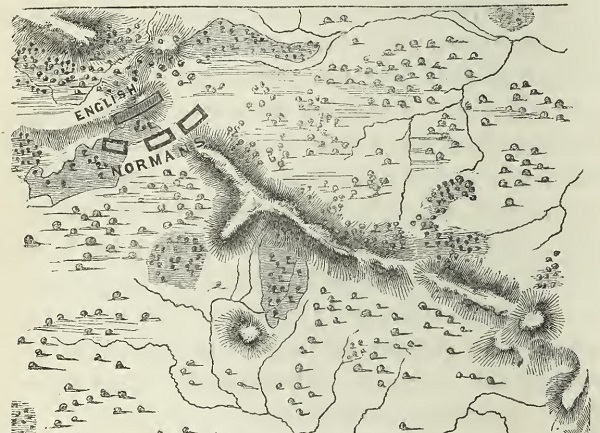 Creasy
Creasy Freeman
Freeman George
George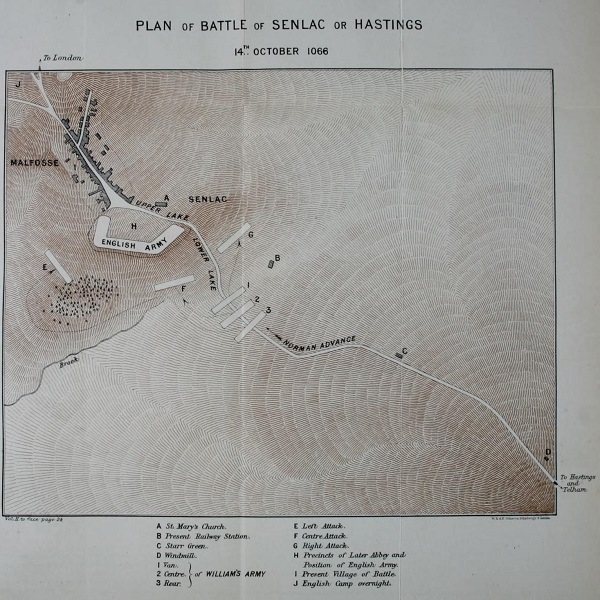 Ramsay
Ramsay Major James
Major James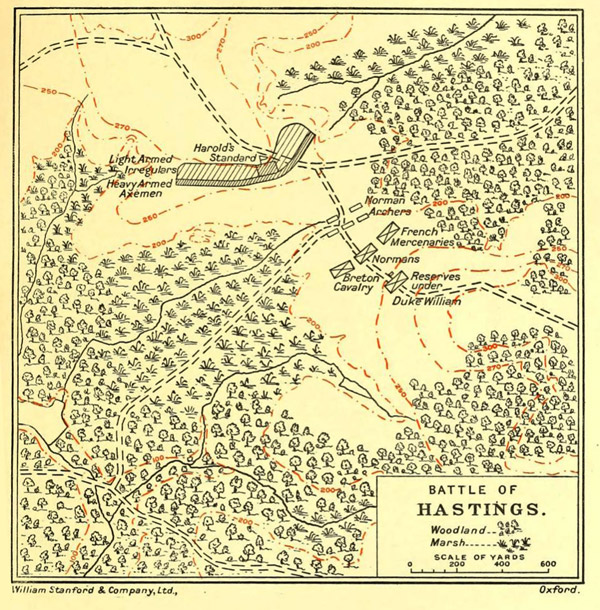 Salzman
Salzman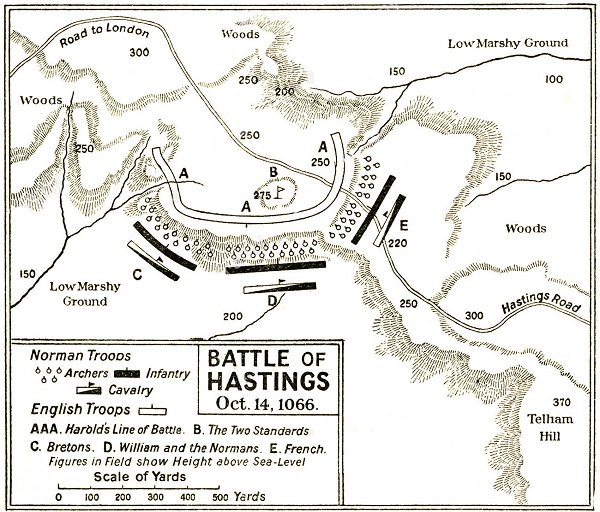 Omar
Omar Burne
Burne Fuller
Fuller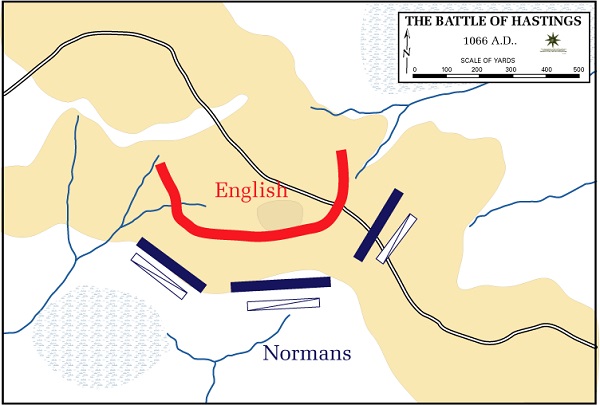 US Military Academy (also Wikipedia), based on Omar
US Military Academy (also Wikipedia), based on Omar Colonel Lemmon
Colonel Lemmon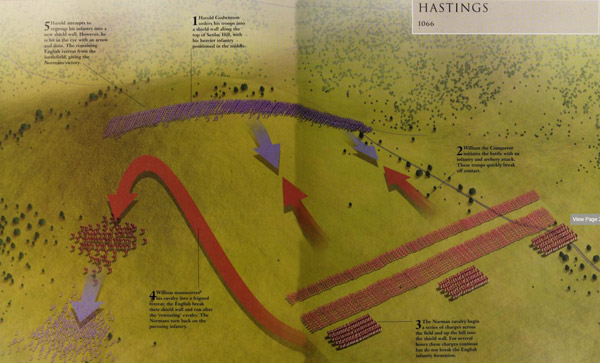 DeVries 2006
DeVries 2006 Morillo composite
Morillo composite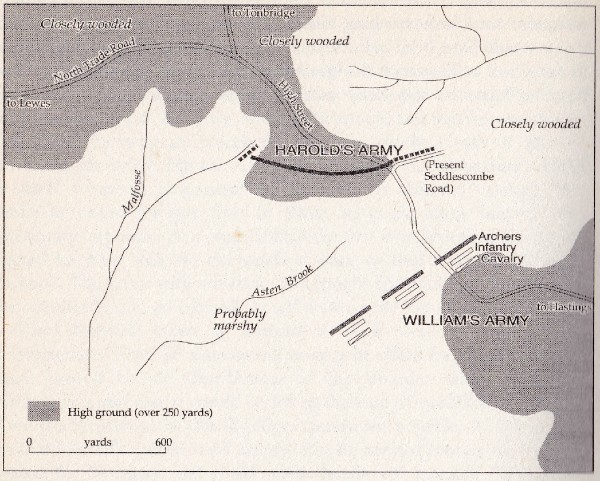 McLynn
McLynn DeVries (2017)
DeVries (2017) Gravett
Gravett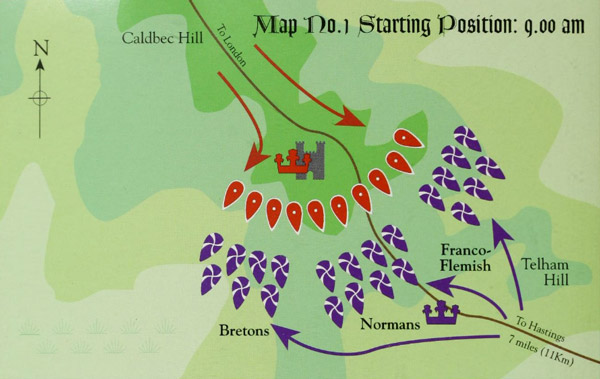 Parker
Parker